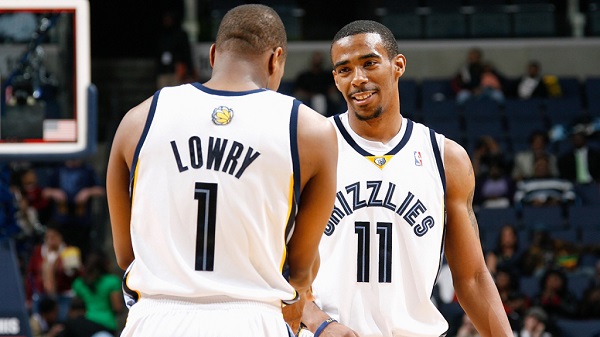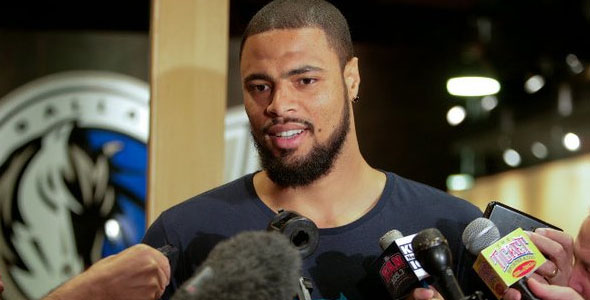Kyle Lowry is having an incredible season and even though he was an All-Star in 2016 he may still be the most underrated player in the NBA.
He is the heart and soul of a 41-20 Raptors team competing for the Eastern Conference’s top seed and has increased his scoring average by four points, his shooting percentage by four percentage points, his three point shooting by six percentage points, his free throw shooting by five percentage points and is a Top 10 player in the NBA by Player Efficiency Rating, at 23.7.
Lowry is averaging 21.6 points, 6.4 assists, 4.9 rebounds, 2.2 steals and is shooting 45%-39%-85% from the field.
A big part of his improvement this season is his body transformation from the offseason. Lowry lost 15 pounds and lowered his body fat percentage to 4.3%.
Here is Lowry discussing the transformation with ESPN Reporter Mike Mazzeo in January:
“I want to play longer, to be a more effective player into my mid-to-late 30s,” said Lowry. “I don’t want to be a guy that’s just out there to be out there; I want to play and contribute. So for me it’s just maintaining it. Now I’m at a point to where it’s, ‘How do I get even better?’ I’m at a point to where I want to be even better.”
Lowry was also frustrated after another early playoff exit to the Wizards last season and didn’t like the criticism he was starting to get about his weight, some media members even suggested Lowry weighed as much as 225 but he says he never weighed more than 210 pounds.
Although Lowry is a Top 15 player in the NBA now and the leader of one of the league’s top five to eight teams, it’s almost impossible to believe he struggled to find a home early in his NBA career after being drafted 24th by the Memphis Grizzlies in the 2006 NBA Draft.
This was due in part to his stubbornness and tough exterior which made him hard to coach and not easy to get along with. Here is an excerpt from Johnathan Abram’s article for Grantland about Lowry in 2014:
“…You do this interview with me when I’m younger, you wouldn’t even want to be around me,” Lowry said, recalling the way he’s felt on teams that haven’t given him the trust and responsibility that Toronto has, back to the days when he came off the bench for his AAU team. “It makes you sad. It makes you say, Damn, what else can happen? What do I have to do to prove that I can be somebody? That I can actually play basketball? That I’m actually better than this person or I can actually help a team win? No matter what level it is…”
A lot of Lowry’s stubbornness and unwillingness to trust others came from his upbringing, a father who wasn’t very involved in his life and the resulting feeling that he was always being overlooked (he came off the bench for his AAU team) not only sparked his work ethic and desire to get better, but held him back as well. Lowry as a result received his only real fatherly influence from his older brother Lonnie, who is only five years his elder.
Here is Kyle’s youth coach Dave Distel describing Kyle’s attitude growing up in the Grantland story:
“It took extraordinarily long for most men to even get the chance to talk to him because he just had that stigma in his head that somebody’s out to fuck me,” Distel recalled. “Somebody’s going to screw me and I don’t trust anybody. The only people I trust is my mom, my grandmother, and my brother.”
Lowry carried a chip on his shoulder after being second fiddle through the college recruiting process. The North Philly product was never the number one choice for many of the top programs he was recruited by, such as North Carolina, Syracuse, Kansas and even Xavier, as those programs signed other guards instead of Lowry.
He carried this chip to Villanova, where he and his dogged work ethic and determination showed on the court as he averaged 10-3-3 in two years at Villanova and was a part of the wildcat’s four guard lineup that made two trips to the Elite Eight.
He was traded from the Grizzlies midway through his third season as he wanted an opportunity to show what he could do as a starter but he knew he wouldn’t be given that opportunity in Memphis as the Grizzlies had another young point guard in Mike Conley whom they took 4th in the very same draft as Lowry.
Lowry was traded to the Rockets and in his second full season with the team he was given an opportunity to start under Rick Adelman. In 71 games for the Rockets Lowry proved his mettle as a starting caliber NBA point guard averaging 13.5 points, 6.7 assists and 4.1 rebounds in 34 minutes per game.
An injury and a coaching change caused Lowry to lose his grasp on the starting point guard role for the Rockets in the 2011-12 season as he split time with new addition Goran Dragic and was traded to the Toronto Raptors in the 2012 offseason. A move Lowry has not initially happy about according to the Grantland story.
“I didn’t want to get traded,” Lowry said. “I knew [Toronto was] trying to get Steve Nash. This is what they said: They wanted Steve Nash to be the point guard for two years and then me learn behind Nash and to get paid and be the starter after Steve called it a career. I said, ‘No, I don’t want to be a backup. You’re not trading for me to be a backup.’ They did the trade anyway, but they didn’t get Steve.”
Lowry dealt with an injury in his first training camp with the Raptors and once again found himself coming off the bench and overlooked as he was backing up starter Jose Calderon.
According to the story, he was extremely frustrated with the situation and resorted to his usual tactics of separating himself from the team and mistrusting those in the organization.
This all changed in the summer of 2013 when current Raptors General Manager Massai Ujiri was hired and first met Lowry in his office.
Ujiri told him the buzz around the league was that Lowry was a really good player on the court but his body language, attitude toward teammates in the locker room and challenging of authority were what teams were weary about with Lowry. Ujiri told Lowry these were all things he could easily improve if he wanted to.
Here is an excerpt from the Grantland story about their conversation:
“Do you want to be a $3 million player, $2 million player for the rest of your career and become a minimum player or do you want to be a $10 million player or more?” he asked. “Talent says you are that type of player, but the attitude and the way you carry yourself says the other. You can be so much better.”
Calderon was traded that offseason and the keys and trust of the franchise was given to Lowry and in turn Lowry matured and got past his authority issues and put his trust in management and Head Coach Dwayne Casey and started to become the point guard he was always capable of being.
Lowry has averaged 19-7-4 for the Raptors the past three seasons and has been one of the five to seven best point guards in the NBA. Now he has helped transform the Raptors into a contender in the Eastern Conference for the first time in 15 years.
It just is another example of the magic and transformation that can happen when the right player and the right franchise come together to take each other to new heights.
























